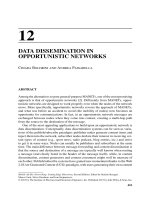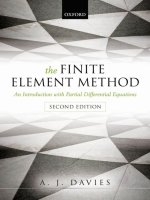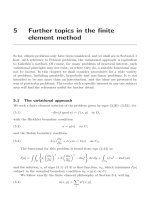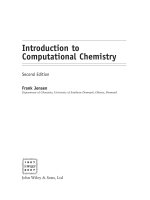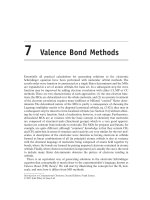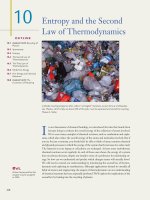Ebook Essential calculus Early transcendentals (2nd edition) Part 1
Bạn đang xem bản rút gọn của tài liệu. Xem và tải ngay bản đầy đủ của tài liệu tại đây (9.33 MB, 452 trang )
Copyright 2012 Cengage Learning. All Rights Reserved. May not be copied, scanned, or duplicated, in whole or in part. Due to electronic rights, some third party content may be suppressed from the eBook and/or eChapter(s).
Editorial review has deemed that any suppressed content does not materially affect the overall learning experience. Cengage Learning reserves the right to remove additional content at any time if subsequent rights restrictions require it.
Use this QR code for a shortcut
to stewartcalculus.com
Now that you have the book, enhance it with these
free online resources at stewartcalculus.com:
• Review of Algebra, Analytic
Geometry, and Conic Sections
• Homework Hints
• Additional Examples
• Additional Topics
• Computer Animations
• Lies My Calculator and
Computer Told Me
• Challenge Problems
• Projects
• And much more...
WEB PROJECTS
These projects can be completed anytime after you have studied the corresponding section in the textbook.
To select a project, go to www.stewartcalculus.com and click on PROJECTS.
2
DERIVATIVES
2.1 WRITING PROJECT
■
2.3
■
2.5
2.6
2.8
3
INVERSE FUNCTIONS
4
APPLICATIONS OF DIFFERENTIATION
5
INTEGRALS
Early Methods for Finding Tangents
APPLIED PROJECT
Building a Better Roller Coaster
APPLIED PROJECT ■ Where Should a Pilot Start Descent?
LABORATORY PROJECT ■ Families of Implicit Curves
LABORATORY PROJECT ■ Taylor Polynomials
3.7 WRITING PROJECT
■
The Origins of L’Hospital’s Rule
4.1 APPLIED PROJECT
■
4.5 APPLIED PROJECT
■
The Calculus of Rainbows
The Shape of a Can
5.3 DISCOVERY PROJECT
5.4 WRITING PROJECT
■
APPLIED PROJECT
■
Area Functions
Newton, Leibniz, and the Invention of Calculus
Where To Sit at the Movies
■
6
TECHNIQUES OF INTEGRATION
6.4 DISCOVERY PROJECT
7
APPLICATIONS OF INTEGRATION
7.1 APPLIED PROJECT
The Gini Index
7.2 DISCOVERY PROJECT ■ Rotating on a Slant
7.4 DISCOVERY PROJECT ■ Arc Length Contest
7.5 APPLIED PROJECT ■ Calculus and Baseball
7.6 APPLIED PROJECT ■ How Fast Does a Tank Drain?
APPLIED PROJECT ■ Which Is Faster, Going Up or Coming Down?
8
SERIES
8.1 LABORATORY PROJECT
■
8.7 LABORATORY PROJECT
■
9
■
Patterns in Integrals
■
WRITING PROJECT
■
8.8 APPLIED PROJECT
■
Logistic Sequences
An Elusive Limit
How Newton Discovered the Binomial Series
Radiation from the Stars
PARAMETRIC EQUATIONS
9.1 LABORATORY PROJECT
■
AND POLAR COORDINATES
9.2 LABORATORY PROJECT
■
9.3 LABORATORY PROJECT
■
10 VECTORS AND
THE GEOMETRY OF SPACE
11 PARTIAL DERIVATIVES
10.4 DISCOVERY PROJECT
Running Circles Around Circles
Bézier Curves
Families of Polar Curves
The Geometry of a Tetrahedron
Putting 3D in Perspective
10.5 LABORATORY PROJECT
10.9 APPLIED PROJECT ■ Kepler’s Laws
■
■
11.7 APPLIED PROJECT
■
DISCOVERY PROJECT
11.8 APPLIED PROJECT
■
APPLIED PROJECT
■
12.5 DISCOVERY PROJECT
Designing a Dumpster
Quadratic Approximations and Critical Points
Rocket Science
Hydro-Turbine Optimization
■
12 MULTIPLE INTEGRALS
Volumes of Hyperspheres
12.6 DISCOVERY PROJECT ■ The Intersection of Three Cylinders
12.7 LABORATORY PROJECT ■ Families of Surfaces
APPLIED PROJECT ■ Roller Derby
13 VECTOR CALCULUS
13.8 WRITING PROJECT
■
■
Three Men and Two Theorems
ESSENTIAL CALCULUS
Early Transcendentals
SECOND EDITION
JAMES STEWART
McMaster University
and
University of Toronto
Australia . Brazil . Japan . Korea . Mexico . Singapore . Spain . United Kingdom . United States
Essential Calculus: Early Transcendentals,
Second Edition
James Stewart
Executive Editor: Liz Covello
Developmental Editor: Carolyn Crockett
Assistant Editor: Liza Neustaetter
Editorial Assistant: Jennifer Staller
Media Editor: Maureen Ross
© 2013, 2007 Brooks/Cole, Cengage Learning
ALL RIGHTS RESERVED. No part of this work covered by the copyright herein may be reproduced, transmitted, stored, or used in any
form or by any means graphic, electronic, or mechanical, including
but not limited to photocopying, recording, scanning, digitizing,
taping, Web distribution, information networks, or information storage and retrieval systems, except as permitted under Section 107 or
108 of the 1976 United States Copyright Act, without the prior written permission of the publisher.
Marketing Manager: Jennifer Jones
For product information and technology assistance, contact us at
Cengage Learning Customer & Sales Support, 1-800-354-9706
Marketing Coordinator: Michael Ledesma
Marketing Communications Manager:
Mary Anne Payumo
For permission to use material from this text or product,
submit all requests online at www.cengage.com/permissions
Further permissions questions can be e-mailed to
Content Project Manager: Cheryll Linthicum
Art Director: Vernon Boes
Manufacturing Planner: Becky Cross
Rights Acquisitions Specialist: Roberta Broyer
Production and Composition Service: TECH·arts
Photo Researcher: Terri Wright
Library of Congress Control Number: 2011942869
ISBN-13: 978-1-133-11228-0
ISBN-10: 1-133-11228-5
Text Researcher: Terri Wright
Copy Editor: Kathi Townes
Brooks/Cole
Compositor: Stephanie Kuhns
20 Davis Drive
Belmont, CA 94002-3098
Illustrator: TECH·arts
USA
Text Designer: Geri Davis
Cover Designer: Denise Davidson
Cover Image: Denise Davidson
Cengage Learning is a leading provider of customized learning
solutions with office locations around the globe, including Singapore,
the United Kingdom, Australia, Mexico, Brazil, and Japan. Locate your
local office at www.cengage.com/global.
Cengage Learning products are represented in Canada by Nelson
Education, Ltd.
To learn more about Brooks/Cole, visit
www.cengage.com/brookscole
Purchase any of our products at your local college store or at our
preferred online store www.cengagebrain.com.
Printed in the United States of America
K07T12
Trademarks
Derive is a registered trademark of Soft Warehouse, Inc.
Maple is a registered trademark of Waterloo Maple, Inc.
Mathematica is a registered trademark of Wolfram Research, Inc.
Tools for Enriching is a trademark used herein under license.
2 3 4 5 6 7 8 16 15 14 13 12
Unless otherwise noted, all content on this page is © Cengage Learning.
This is an electronic version of the print textbook. Due to electronic rights restrictions,
some third party content may be suppressed. Editorial review has deemed that any suppressed
content does not materially affect the overall learning experience. The publisher reserves the right
to remove content from this title at any time if subsequent rights restrictions require it. For
valuable information on pricing, previous editions, changes to current editions, and alternate
formats, please visit www.cengage.com/highered to search by ISBN#, author, title, or keyword for
materials in your areas of interest.
CONTENT S
Preface
ix
To the Student
xvi
Diagnostic Tests
xvii
1
FUNCTIONS AND LIMITS
1.1
1.2
1.3
1.4
1.5
1.6
2
3
Functions and Their Representations 1
A Catalog of Essential Functions 11
The Limit of a Function 24
Calculating Limits 35
Continuity 46
Limits Involving Infinity 56
Review
70
DERIVATIVES
2.1
2.2
2.3
2.4
2.5
2.6
2.7
2.8
1
73
Derivatives and Rates of Change 73
The Derivative as a Function 84
Basic Differentiation Formulas 95
The Product and Quotient Rules 107
The Chain Rule 114
Implicit Differentiation 123
Related Rates 128
Linear Approximations and Differentials
Review
140
135
INVERSE FUNCTIONS: Exponential, Logarithmic, and
Inverse Trigonometric Functions
145
3.1
3.2
3.3
Unless otherwise noted, all content on this page is © Cengage Learning.
Exponential Functions 145
Inverse Functions and Logarithms 151
Derivatives of Logarithmic and Exponential Functions
163
iii
iv
CONTENTS
3.4
3.5
3.6
3.7
4
INTEGRALS
5.1
5.2
5.3
5.4
5.5
6
191
APPLICATIONS OF DIFFERENTIATION
4.1
4.2
4.3
4.4
4.5
4.6
4.7
5
Exponential Growth and Decay 171
Inverse Trigonometric Functions 179
Hyperbolic Functions 184
Indeterminate Forms and l’Hospital’s Rule
Review
199
Maximum and Minimum Values 203
The Mean Value Theorem 210
Derivatives and the Shapes of Graphs 216
Curve Sketching 225
Optimization Problems 231
Newton’s Method 242
Antiderivatives 247
Review
253
257
Areas and Distances 257
The Definite Integral 268
Evaluating Definite Integrals 281
The Fundamental Theorem of Calculus
The Substitution Rule 300
Review
308
TECHNIQUES OF INTEGRATION
6.1
6.2
6.3
6.4
6.5
6.6
203
291
311
Integration by Parts 311
Trigonometric Integrals and Substitutions 317
Partial Fractions 327
Integration with Tables and Computer Algebra Systems
Approximate Integration 341
Improper Integrals 353
Review
362
335
Unless otherwise noted, all content on this page is © Cengage Learning.
CONTENTS
7
APPLICATIONS OF INTEGRATION
7.1
7.2
7.3
7.4
7.5
7.6
7.7
8
SERIES
365
Areas Between Curves 365
Volumes 370
Volumes by Cylindrical Shells 381
Arc Length 386
Area of a Surface of Revolution 393
Applications to Physics and Engineering
Differential Equations
412
Review
421
398
425
8.1
8.2
8.3
8.4
8.5
8.6
8.7
8.8
9
v
Sequences 425
Series 436
The Integral and Comparison Tests 446
Other Convergence Tests 454
Power Series 464
Representing Functions as Power Series 470
Taylor and Maclaurin Series 476
Applications of Taylor Polynomials
489
Review
497
PARAMETRIC EQUATIONS AND POLAR COORDINATES
9.1
9.2
9.3
9.4
9.5
Unless otherwise noted, all content on this page is © Cengage Learning.
Parametric Curves 501
Calculus with Parametric Curves 508
Polar Coordinates 515
Areas and Lengths in Polar Coordinates 524
Conic Sections in Polar Coordinates 529
Review
535
501
vi
CONTENTS
10
VECTORS AND THE GEOMETRY OF SPACE
10.1
10.2
10.3
10.4
10.5
10.6
10.7
10.8
10.9
11
12
Three-Dimensional Coordinate Systems 537
Vectors 542
The Dot Product 551
The Cross Product 558
Equations of Lines and Planes 566
Cylinders and Quadric Surfaces 574
Vector Functions and Space Curves 580
Arc Length and Curvature 591
Motion in Space: Velocity and Acceleration 600
Review
610
PARTIAL DERIVATIVES
11.1
11.2
11.3
11.4
11.5
11.6
11.7
11.8
615
Functions of Several Variables 615
Limits and Continuity 626
Partial Derivatives 633
Tangent Planes and Linear Approximations 641
The Chain Rule 649
Directional Derivatives and the Gradient Vector 658
Maximum and Minimum Values 669
Lagrange Multipliers 677
Review
685
MULTIPLE INTEGRALS
12.1
12.2
12.3
12.4
12.5
12.6
12.7
12.8
537
689
Double Integrals over Rectangles 689
Double Integrals over General Regions 700
Double Integrals in Polar Coordinates 709
Applications of Double Integrals 715
Triple Integrals 720
Triple Integrals in Cylindrical Coordinates 731
Triple Integrals in Spherical Coordinates 735
Change of Variables in Multiple Integrals 742
Review
751
Unless otherwise noted, all content on this page is © Cengage Learning.
CONTENTS
13
VECTOR CALCULUS
13.1
13.2
13.3
13.4
13.5
13.6
13.7
13.8
13.9
Vector Fields 755
Line Integrals 761
The Fundamental Theorem for Line Integrals
Green’s Theorem 782
Curl and Divergence 789
Parametric Surfaces and Their Areas 797
Surface Integrals 807
Stokes’ Theorem 818
The Divergence Theorem 823
Review
830
APPENDIXES
A
B
C
D
E
INDEX
Unless otherwise noted, all content on this page is © Cengage Learning.
755
A1
Trigonometry A1
Sigma Notation A10
The Logarithm Defined as an Integral
Proofs A22
Answers to Odd-Numbered Exercises
A89
A15
A39
773
vii
PREFACE
This book is a response to those instructors who feel that calculus textbooks are too
big. In writing the book I asked myself: What is essential for a three-semester calculus course for scientists and engineers?
The book is about two-thirds the size of my other calculus books (Calculus, Seventh
Edition and Calculus, Early Transcendentals, Seventh Edition) and yet it contains
almost all of the same topics. I have achieved relative brevity mainly by condensing
the exposition and by putting some of the features on the website www.stewartcalculus.com. Here, in more detail are some of the ways I have reduced the bulk:
■
I have organized topics in an efficient way and rewritten some sections
with briefer exposition.
■
The design saves space. In particular, chapter opening spreads and photographs have been eliminated.
■
The number of examples is slightly reduced. Additional examples are
provided online.
■
The number of exercises is somewhat reduced, though most instructors
will find that there are plenty. In addition, instructors have access to the
archived problems on the website.
■
Although I think projects can be a very valuable experience for students,
I have removed them from the book and placed them on the website.
■
A discussion of the principles of problem solving and a collection of
challenging problems for each chapter have been moved to the website.
Despite the reduced size of the book, there is still a modern flavor: Conceptual
understanding and technology are not neglected, though they are not as prominent as
in my other books.
ALTERNATE VERSIONS
I have written several other calculus textbooks that might be preferable for some
instructors. Most of them also come in single variable and multivariable versions.
■
■
■
■
Unless otherwise noted, all content on this page is © Cengage Learning.
Essential Calculus, Second Edition, is similar to the present textbook except
that the logarithm is defined as an integral and so the exponential, logarithmic, and inverse trigonometric functions are covered later than in the present
book.
Calculus: Early Transcendentals, Seventh Edition, has more complete coverage of calculus than the present book, with somewhat more examples and
exercises.
Calculus: Early Transcendentals, Seventh Edition, Hybrid Version, is similar
to Calculus: Early Transcendentals, Seventh Edition, in content and coverage
except that all of the end-of-section exercises are available only in Enhanced
WebAssign. The printed text includes all end-of-chapter review material.
Calculus, Seventh Edition, is similar to Calculus: Early Transcendentals,
Seventh Edition, except that the exponential, logarithmic, and inverse trigonometric functions are covered in the second semester. It is also available
in a Hybrid Version.
ix
x
PREFACE
■
■
■
Calculus: Concepts and Contexts, Fourth Edition, emphasizes conceptual
understanding. The coverage of topics is not encyclopedic and the material on
transcendental functions and on parametric equations is woven throughout the
book instead of being treated in separate chapters. It is also available in a
Hybrid Version.
Calculus: Early Vectors introduces vectors and vector functions in the first
semester and integrates them throughout the book. It is suitable for students
taking Engineering and Physics courses concurrently with calculus.
Brief Applied Calculus is intended for students in business, the social sciences,
and the life sciences. It is also available in a Hybrid Version.
WHAT’S NEW IN THE SECOND EDITION?
The changes have resulted from talking with my colleagues and students at the University of Toronto and from reading journals, as well as suggestions from users and
reviewers. Here are some of the many improvements that I’ve incorporated into this
edition:
■
At the beginning of the book there are four diagnostic tests, in Basic Algebra,
Analytic Geometry, Functions, and Trigonometry. Answers are given and students
who don’t do well are referred to where they should seek help (Appendixes,
review sections of Chapter 1, and the website).
■
Section 7.5 (Area of a Surface of Revolution) is new. I had asked reviewers if
there was any topic missing from the first edition that they regarded as essential.
This was the only topic that was mentioned by more than one reviewer.
■
Some material has been rewritten for greater clarity or for better motivation. See,
for instance, the introduction to maximum and minimum values on pages 203–04
and the introduction to series on page 436.
■
New examples have been added (see Example 4 on page 725 for instance). And
the solutions to some of the existing examples have been amplified. A case in
point: I added details to the solution of Example 1.4.9 because when I taught
Section 1.4 from the first edition I realized that students need more guidance
when setting up inequalities for the Squeeze Theorem.
■
The data in examples and exercises have been updated to be more timely.
■
Several new historical margin notes have been added.
■
About 40% of the exercises are new. Here are some of my favorites: 1.6.43,
2.2.13–14, 2.5.59, 2.6.39– 40, 3.2.70, 4.3.66, 5.3.44–45, 7.6.24, 8.2.29–30,
8.7.67–68, 10.1.38, 10.4.43– 44
■
The animations in Tools for Enriching Calculus (TEC) have been completely
redesigned and are accessible in Enhanced WebAssign, CourseMate, and
PowerLecture. Selected Visuals and Modules are available at
www.stewartcalculus.com.
CONTENT
DIAGNOSTIC TESTS The book begins with four diagnostic tests, in Basic Algebra,
Analytic Geometry, Functions, and Trigonometry.
■
FUNCTIONS AND LIMITS After a brief review of the basic functions,
limits and continuity are introduced, including limits of trigonometric functions, limits involving infinity, and precise definitions.
CHAPTER 1
■
Unless otherwise noted, all content on this page is © Cengage Learning.
PREFACE
xi
CHAPTER 2 DERIVATIVES The material on derivatives is covered in two sections in
order to give students time to get used to the idea of a derivative as a function. The
formulas for the derivatives of the sine and cosine functions are derived in the section
on basic differentiation formulas. Exercises explore the meanings of derivatives in
various contexts.
■
CHAPTER 3 ■ INVERSE FUNCTIONS: EXPONENTIAL, LOGARITHMIC, AND INVERSE TRIGONOMETRIC FUNCTIONS Exponential functions are defined first and the number e is defined
as a limit. Logarithms are then defined as inverse functions. Applications to exponential growth and decay follow. Inverse trigonometric functions and hyperbolic functions are also covered here. L’Hospital’s Rule is included in this chapter because limits
of transcendental functions so often require it.
APPLICATIONS OF DIFFERENTIATION The basic facts concerning
extreme values and shapes of curves are deduced from the Mean Value Theorem. The
section on curve sketching includes a brief treatment of graphing with technology. The
section on optimization problems contains a brief discussion of applications to business and economics.
CHAPTER 4
■
CHAPTER 5 INTEGRALS The area problem and the distance problem serve to motivate the definite integral, with sigma notation introduced as needed. (Full coverage of
sigma notation is provided in Appendix B.) A quite general definition of the definite
integral (with unequal subintervals) is given initially before regular partitions are
employed. Emphasis is placed on explaining the meanings of integrals in various contexts and on estimating their values from graphs and tables.
■
CHAPTER 6 TECHNIQUES OF INTEGRATION All the standard methods are covered,
as well as computer algebra systems, numerical methods, and improper integrals.
■
CHAPTER 7 APPLICATIONS OF INTEGRATION General methods are emphasized.
The goal is for students to be able to divide a quantity into small pieces, estimate with
Riemann sums, and recognize the limit as an integral. The chapter concludes with an
introduction to differential equations, including separable equations and direction
fields.
■
SERIES The convergence tests have intuitive justifications as well as
formal proofs. The emphasis is on Taylor series and polynomials and their applications to physics. Error estimates include those based on Taylor’s Formula (with
Lagrange’s form of the remainder term) and those from graphing devices.
CHAPTER 8
■
PARAMETRIC EQUATIONS AND POLAR COORDINATES This chapter
introduces parametric and polar curves and applies the methods of calculus to them.
A brief treatment of conic sections in polar coordinates prepares the way for Kepler’s
Laws in Chapter 10.
CHAPTER 9
■
VECTORS AND THE GEOMETRY OF SPACE In addition to the material
on vectors, dot and cross products, lines, planes, and surfaces, this chapter covers vectorvalued functions, length and curvature of space curves, and velocity and acceleration
along space curves, culminating in Kepler’s laws.
CHAPTER 10
■
CHAPTER 11 PARTIAL DERIVATIVES In view of the fact that many students have difficulty forming mental pictures of the concepts of this chapter, I’ve placed a special
emphasis on graphics to elucidate such ideas as graphs, contour maps, directional
derivatives, gradients, and Lagrange multipliers.
■
Unless otherwise noted, all content on this page is © Cengage Learning.
xii
PREFACE
MULTIPLE INTEGRALS Cylindrical and spherical coordinates are introduced in the context of evaluating triple integrals.
CHAPTER 12
■
CHAPTER 13 VECTOR CALCULUS The similarities among the Fundamental Theorem
for line integrals, Green’s Theorem, Stokes’ Theorem, and the Divergence Theorem
are emphasized.
■
WEBSITE
The web site www.stewartcalulus.com includes the following.
■
Review of Algebra, Trigonometry, Analytic Geometry, and Conic Sections
■
Homework Hints
■
Additional Examples
■
Projects
■
Archived Problems (drill exercises that were in previous editions of my
other books), together with their solutions
■
Challenge Problems
■
Lies My Calculator and Computer Told Me
■
Additional Topics (complete with exercise sets): Principles of Problem
Solving, Strategy for Integration, Strategy for Testing Series, Fourier Series,
Linear Differential Equations, Second Order Linear Differential Equations,
Nonhomogeneous Linear Equations, Applications of Second Order Differential Equations, Using Series to Solve Differential Equations, Complex
Numbers, Rotation of Axes
■
Links, for particular topics, to outside Web resources
■
History of Mathematics, with links to the better historical websites
■
TEC animations for Chapters 2 and 5
ACKNOWLEDGMENTS
I thank the following reviewers for their thoughtful comments:
SECOND EDITION REVIEWERS
Allison Arnold, University of Georgia
Rachel Belinsky, Georgia State University
Geoffrey D. Birky, Georgetown University
Przemyslaw Bogacki, Old Dominion University
Mark Brittenham, University of Nebraska at Lincoln
Katrina K. A. Cunningham, Southern University and A&M College
Morley Davidson, Kent State University
M. Hilary Davies, University of Alaska Anchorage
Shelby J. Kilmer, Missouri State University
Ilya Kofman, College of Staten Island, CUNY
Ramendra Krishna Bose, University of Texas–Pan American
Unless otherwise noted, all content on this page is © Cengage Learning.
PREFACE
xiii
Melvin Lax, California State University Long Beach
Derek Martinez, Central New Mexico Community College
Alex M. McAllister, Centre College
Michael McAsey, Bradley University
Humberto Munoz, Southern University and A&M College
Charlotte Newsom, Tidewater Community College
Michael Price, University of Oregon
Joe Rody, Arizona State University
Vicki Sealey, West Virginia University
David Shannon, Transylvania University
Ulrich Albrecht, Auburn University
FIRST EDITION REVIEWERS
Christopher Butler, Case Western Reserve University
Joe Fisher, University of Cincinnati
John Goulet, Worchester Polytechnic Institute
Irvin Hentzel, Iowa State University
Joel Irish, University of Southern Maine
Mary Nelson, University of Colorado, Boulder
Ed Slaminka, Auburn University
Li (Jason) Zhongshan, Georgia State University
I also thank Jim Propp of the University of Massachusetts–Lowell for a number of
suggestions resulting from his teaching from the first edition.
In addition, I thank Kathi Townes and Stephanie Kuhns for their production services and the following Brooks/Cole staff: Cheryll Linthicum, editorial content project
manager; Vernon Boes, art director; Jennifer Jones and Mary Anne Payumo, marketing team; Maureen Ross, media editor; Carolyn Crockett, development editor; Elizabeth Neustaetter, assistant editor; Jennifer Staller, editorial assistant; Roberta Broyer,
rights acquisitions specialist; Becky Cross, manufacturing planner; and Denise Davidson, cover designer. They have all done an outstanding job.
The idea for this book came from my former editor Bob Pirtle, who had been hearing of the desire for a much shorter calculus text from numerous instructors. I thank
my present editor Liz Covello for sustaining and supporting this idea in the second
edition.
JAMES STEWART
Unless otherwise noted, all content on this page is © Cengage Learning.
xiv
PREFACE
ANCILLARIES FOR INSTRUCTORS
PowerLecture
ISBN 1-133-52566-0
This comprehensive DVD contains all art from the text in both
jpeg and PowerPoint formats, complete pre-built PowerPoint
lectures, an electronic version of the Instructor’s Guide,
Solution Builder, ExamView algorithmic testing software,
Tools for Enriching Calculus, and video instruction.
Instructor’s Guide
By Douglas Shaw
ISBN 1-133-52510-5
Each section of the text is discussed from several viewpoints.
The Instructor’s Guide contains suggested time to allot, points
to stress, text discussion topics, core materials for lecture,
work-show/discussion suggestions, group work exercises in a
form suitable for handout, and suggested homework assignments. An electronic version of the Instructor’s Guide is available on the PowerLecture DVD.
Complete Solutions Manual
ISBN 1-133-36444-6
Includes worked-out solutions to all exercises in the text.
Solution Builder
www.cengage.com/solutionbuilder
This online instructor database offers complete worked-out
solutions to all exercises in the text. Solution Builder allows
you to create customized, secure solution printouts (in PDF
format) matched exactly to the problems you assign in class.
Additional Examples ■ Projects ■ Archived Problems ■
Challenge Problems ■ Lies My Calculator and Computer
Told Me ■ Principles of Problem Solving ■ Additional
Topics ■ Web Links ■ History of Mathematics
TEC Tools for Enriching™ Calculus
By James Stewart, Harvey Keynes, Dan Clegg, and
developer Hu Hohn
Tools for Enriching Calculus (TEC) functions as both a powerful tool for instructors, as well as a tutorial environment in
which students can explore and review selected topics. The
Flash simulation modules in TEC include instructions, written
and audio explanations, and exercises. TEC modules are
assignable in Enhanced WebAssign. TEC is also available at
www.stewartcalculus.com, as well as in the YouBook and
CourseMate.
Enhanced WebAssign
www.webassign.net
WebAssign’s homework system lets instructors deliver, collect,
and record assignments via the Web. Enhanced WebAssign for
Stewart’s Essential Calculus: Early Transcendentals now
includes opportunities for students to review prerequisite skills
and content both at the start of the course and at the beginning
of each section. In addition, for selected problems, students can
get extra help in the form of “enhanced feedback” (rejoinders)
and video solutions. Other key features include: thousands of
problems from Stewart’s Essential Calculus: Early Transcendentals, a QuickPrep for Calculus review, a customizable
Cengage YouBook, Just In Time Review questions, a Show My
Work feature, assignable Tools for Enriching Calculus modules, quizzes, lecture videos (with associated questions), and
more!
ExamView Algorithmic Testing
Create, deliver, and customize tests in print and online formats
with ExamView, an easy-to-use assessment and tutorial software. ExamView contains hundreds of multiple-choice,
numerical response, and short answer test items. ExamView
algorithmic testing is available on the PowerLecture DVD.
ANCILLARIES FOR INSTRUCTORS AND STUDENTS
Stewart Website
www.stewartcalculus.com
Contents: Review of Algebra, Trigonometry, Analytic
Geometry, and Conic Sections ■ Homework Hints ■
Cengage Customizable YouBook
YouBook is an eBook that is both interactive and customizable! Containing all the content from Stewart’s Essential
Calculus: Early Transcendentals, YouBook features a text edit
tool that allows instructors to modify the textbook narrative as
needed. With YouBook, instructors can quickly reorder entire
sections and chapters or hide any content they don’t teach to
create an eBook that perfectly matches their syllabus. Instructors
can further customize the text by adding instructor-created or
YouTube video links. Additional media assets include: Tools
for Enriching Calculus visuals and modules, Wolfram animations, video clips, highlighting, notes, and more! YouBook is
available in Enhanced WebAssign.
Unless otherwise noted, all content on this page is © Cengage Learning.
PREFACE
CourseMate
www.cengagebrain.com
CourseMate is a perfect self-study tool for students, and
requires no set-up from instructors. CourseMate brings
course concepts to life with interactive learning, study, and
exam preparation tools that support the printed textbook.
CourseMate for Stewart’s Essential Calculus: Early Transcendentals includes: an interactive eBook, Tools for Enriching
Calculus, videos, quizzes, flashcards, and more! For instructors, CourseMate includes engagement tracker, a first-of-its
kind tool that monitors student engagement.
Maple
Maple™ is an essential tool that allows you to explore, visualize, and solve even the most complex mathematical problems,
reducing errors and providing greater insight into the math.
Maple’s world-leading computation engine offers the breadth,
depth, and performance to handle every type of mathematics.
With Maple, teachers can bring complex problems to life and
students can focus on concepts rather than the mechanics of
solutions. Maple’s intuitive interface supports multiple styles
of interaction, from Clickable Math™ tools to a sophisticated
programming language.
CengageBrain.com
To access additional course materials and companion
resources, please visit www.cengagebrain.com. At the
CengageBrain.com home page, search for the ISBN of your
title (from the back cover of your book) using the search box
at the top of the page. This will take you to the product page
where free companion resources can be found.
xv
CalcLabs with Maple
SINGLE VARIABLE By Robert J. Lopez and Philip B. Yasskin
ISBN 0-8400-5811-X
MULTIVARIABLE By Robert J. Lopez and Philip B. Yasskin
ISBN 0-8400-5812-8
CalcLabs with Mathematica
SINGLE VARIABLE By Selwyn Hollis
ISBN 0-8400-5814-4
MULTIVARIABLE By Selwyn Hollis
ISBN 0-8400-5813-6
Each of these comprehensive lab manuals will help students
learn to use the technology tools available to them. CalcLabs
contain clearly explained exercises and a variety of labs and
projects.
A Companion to Calculus
By Dennis Ebersole, Doris Schattschneider, Alicia Sevilla,
and Kay Somers
ISBN 0-495-01124-X
Written to improve algebra and problem-solving skills of students taking a calculus course, every chapter in this companion
is keyed to a calculus topic, providing conceptual background
and specific algebra techniques needed to understand and solve
calculus problems related to that topic. It is designed for calculus courses that integrate the review of precalculus concepts or
for individual use.
Linear Algebra for Calculus
ANCILLARIES FOR STUDENTS
Student Solutions Manual
ISBN 1-133-49097-2
Provides completely worked-out solutions to all oddnumbered exercises in the text, giving students a chance to
check their answers and ensure they took the correct steps to
arrive at an answer.
Unless otherwise noted, all content on this page is © Cengage Learning.
By Konrad J. Heuvers, William P. Francis, John H. Kuisti,
Deborah F. Lockhart, Daniel S. Moak, and Gene M. Ortner
ISBN 0-534-25248-6
This comprehensive book, designed to supplement the calculus
course, provides an introduction to and review of the basic
ideas of linear algebra.
TO THE STUDENT
Reading a calculus textbook is different from reading a
newspaper or a novel, or even a physics book. Don’t be discouraged if you have to read a passage more than once in
order to understand it. You should have pencil and paper and
calculator at hand to sketch a diagram or make a calculation.
Some students start by trying their homework problems
and read the text only if they get stuck on an exercise. I suggest that a far better plan is to read and understand a section
of the text before attempting the exercises. In particular, you
should look at the definitions to see the exact meanings of
the terms. And before you read each example, I suggest that
you cover up the solution and try solving the problem yourself. You’ll get a lot more from looking at the solution if you
do so.
Part of the aim of this course is to train you to think logically. Learn to write the solutions of the exercises in a connected, step-by-step fashion with explanatory sentences—
not just a string of disconnected equations or formulas.
The answers to the odd-numbered exercises appear at the
back of the book, in Appendix E. Some exercises ask for a
verbal explanation or interpretation or description. In such
cases there is no single correct way of expressing the
answer, so don’t worry that you haven’t found the definitive
answer. In addition, there are often several different forms in
which to express a numerical or algebraic answer, so if your
answer differs from mine, don’t immediately assume you’re
wrong. For example, if the answer given in the back of the
book is s2 Ϫ 1 and you obtain 1͞(1 ϩ s2 ), then you’re
right and rationalizing the denominator will show that the
answers are equivalent.
The icon ; indicates an exercise that definitely requires
the use of either a graphing calculator or a computer with
graphing software. (The use of these graphing devices and
some of the pitfalls that you may encounter are discussed on
stewartcalculus.com. Go to Additional Topics and click on
Graphing Calculators and Computers.) But that doesn’t
mean that graphing devices can’t be used to check your
work on the other exercises as well. The symbol CAS is
reserved for problems in which the full resources of a computer algebra system (like Derive, Maple, Mathematica, or
the TI-89/92) are required.
You will also encounter the symbol |, which warns you
against committing an error. I have placed this symbol in the
margin in situations where I have observed that a large proportion of my students tend to make the same mistake.
Tools for Enriching Calculus, which is a companion to
this text, is referred to by means of the symbol TEC and
can be accessed in Enhanced WebAssign and CourseMate
(selected Visuals and Modules are available at www.stewartcalculus.com). It directs you to modules in which you can
explore aspects of calculus for which the computer is particularly useful.
There is a lot of useful information on the website
stewartcalculus.com. There you will find a review of precalculus topics (in case your algebraic skills are rusty), as
well as Homework Hints (see the following paragraph),
Additional Examples (see below), Challenge Problems,
Projects, Lies My Calculator and Computer Told Me,
(explaining why calculators sometimes give the wrong
answer), Additional Topics, and links to outside resources.
Homework Hints for representative exercises are indicated by printing the exercise number in blue: 5. These hints
can be found on stewartcalculus.com as well as Enhanced
WebAssign and CourseMate. The homework hints ask you
questions that allow you to make progress toward a solution
without actually giving you the answer. You need to pursue
each hint in an active manner with pencil and paper to work
out the details. If a particular hint doesn’t enable you to
solve the problem, you can click to reveal the next hint.
You will see margin notes in some sections directing
you to Additional Examples on the website. You will also
see the symbol V beside two or three of the examples in
every section of the text. This means that there are videos
(in Enhanced WebAssign and CourseMate) of instructors
explaining those examples in greater detail.
I recommend that you keep this book for reference purposes after you finish the course. Because you will likely
forget some of the specific details of calculus, the book will
serve as a useful reminder when you need to use calculus in
subsequent courses. And, because this book contains more
material than can be covered in any one course, it can also
serve as a valuable resource for a working scientist or
engineer.
Calculus is an exciting subject, justly considered to be
one of the greatest achievements of the human intellect. I
hope you will discover that it is not only useful but also
intrinsically beautiful.
JAMES STEWART
xvi
Copyright 2012 Cengage Learning. All Rights Reserved. May not be copied, scanned, or duplicated, in whole or in part. Due to electronic rights, some third party content may be suppressed from the eBook and/or eChapter(s).
Editorial review has deemed that any suppressed content does not materially affect the overall learning experience. Cengage Learning reserves the right to remove additional content at any time if subsequent rights restrictions require it.
DIAGNOSTIC TEST S
Success in calculus depends to a large extent on knowledge of the mathematics that precedes calculus:
algebra, analytic geometry, functions, and trigonometry. The following tests are intended to diagnose
weaknesses that you might have in these areas. After taking each test you can check your answers
against the given answers and, if necessary, refresh your skills by referring to the review materials that
are provided.
A
DIAGNOSTIC TEST: ALGEBRA
1. Evaluate each expression without using a calculator.
(a) ͑Ϫ3͒4
(b) Ϫ34
23
(d)
5
5 21
(e)
ͩͪ
2
3
(c) 3Ϫ4
Ϫ2
(f ) 16 Ϫ3͞4
2. Simplify each expression. Write your answer without negative exponents.
(a) s200 Ϫ s32
(b) ͑3a 3b 3 ͒͑4ab 2 ͒ 2
(c)
ͩ
3x 3͞2 y 3
x 2 yϪ1͞2
ͪ
Ϫ2
3. Expand and simplify.
(a) 3͑x ϩ 6͒ ϩ 4͑2x Ϫ 5͒
(b) ͑x ϩ 3͒͑4x Ϫ 5͒
(c) (sa ϩ sb )(sa Ϫ sb )
(d) ͑2x ϩ 3͒2
(e) ͑x ϩ 2͒3
4. Factor each expression.
(a) 4x 2 Ϫ 25
(c) x 3 Ϫ 3x 2 Ϫ 4x ϩ 12
(e) 3x 3͞2 Ϫ 9x 1͞2 ϩ 6x Ϫ1͞2
(b) 2x 2 ϩ 5x Ϫ 12
(d) x 4 ϩ 27x
(f ) x 3 y Ϫ 4xy
5. Simplify the rational expression.
(a)
x 2 ϩ 3x ϩ 2
x2 Ϫ x Ϫ 2
(c)
x2
xϩ1
Ϫ
x2 Ϫ 4
xϩ2
2x 2 Ϫ x Ϫ 1
xϩ3
ؒ
x2 Ϫ 9
2x ϩ 1
x
y
Ϫ
x
y
(d)
1
1
Ϫ
y
x
(b)
6. Rationalize the expression and simplify.
(a)
s10
s5 Ϫ 2
(b)
s4 ϩ h Ϫ 2
h
7. Rewrite by completing the square.
(a) x 2 ϩ x ϩ 1
(b) 2x 2 Ϫ 12x ϩ 11
Unless otherwise noted, all content on this page is © Cengage Learning.
Copyright 2012 Cengage Learning. All Rights Reserved. May not be copied, scanned, or duplicated, in whole or in part. Due to electronic rights, some third party content may be suppressed from the eBook and/or eChapter(s).
Editorial review has deemed that any suppressed content does not materially affect the overall learning experience. Cengage Learning reserves the right to remove additional content at any time if subsequent rights restrictions require it.
xvii
xviii
DIAGNOSTIC TESTS
8. Solve the equation. (Find only the real solutions.)
2x Ϫ 1
2x
xϩ1
x
(d) 2x 2 ϩ 4x ϩ 1 0
1
(a) x ϩ 5 14 Ϫ 2 x
(b)
(c) x2 Ϫ x Ϫ 12 0
Խ
(e) x 4 Ϫ 3x 2 ϩ 2 0
(g) 2x͑4 Ϫ x͒Ϫ1͞2 Ϫ 3 s4 Ϫ x 0
Խ
(f ) 3 x Ϫ 4 10
9. Solve each inequality. Write your answer using interval notation.
(b) x 2 Ͻ 2x ϩ 8
(d) x Ϫ 4 Ͻ 3
(a) Ϫ4 Ͻ 5 Ϫ 3x ഛ 17
(c) x͑x Ϫ 1͒͑x ϩ 2͒ Ͼ 0
2x Ϫ 3
(e)
ഛ1
xϩ1
Խ
Խ
10. State whether each equation is true or false.
(a) ͑ p ϩ q͒2 p 2 ϩ q 2
(b) sab sa sb
(c) sa 2 ϩ b 2 a ϩ b
(d)
1 ϩ TC
1ϩT
C
(f )
1͞x
1
a͞x Ϫ b͞x
aϪb
(e)
A
1
1
1
Ϫ
xϪy
x
y
ANSWERS TO DIAGNOSTIC TEST A: ALGEBRA
1. (a) 81
(d) 25
2. (a) 6s2
(b) Ϫ81
(c)
9
4
(f )
(e)
(b) 48a 5b7
(c)
1
81
1
8
x
9y7
3. (a) 11x Ϫ 2
(b) 4x 2 ϩ 7x Ϫ 15
(c) a Ϫ b
(d) 4x 2 ϩ 12x ϩ 9
3
2
(e) x ϩ 6x ϩ 12x ϩ 8
4. (a) ͑2x Ϫ 5͒͑2x ϩ 5͒
(c) ͑x Ϫ 3͒͑x Ϫ 2͒͑x ϩ 2͒
(e) 3xϪ1͞2͑x Ϫ 1͒͑x Ϫ 2͒
xϩ2
xϪ2
1
(c)
xϪ2
5. (a)
(b) ͑2x Ϫ 3͒͑x ϩ 4͒
(d) x͑x ϩ 3͒͑x 2 Ϫ 3x ϩ 9͒
(f ) xy͑x Ϫ 2͒͑x ϩ 2͒
(b)
xϪ1
xϪ3
(d) Ϫ͑x ϩ y͒
6. (a) 5s2 ϩ 2s10
7. (a) ( x ϩ
1 2
2
)
ϩ 34
8. (a) 6
(d) Ϫ1 Ϯ s2
1
2
(g)
(b)
1
s4 ϩ h ϩ 2
(b) 2͑x Ϫ 3͒2 Ϫ 7
(b) 1
(c) Ϫ3, 4
(e) Ϯ1, Ϯs2
2 22
(f ) 3 , 3
12
5
9. (a) ͓Ϫ4, 3͒
(c) ͑Ϫ2, 0͒ ʜ ͑1, ϱ͒
(e) ͑Ϫ1, 4͔
10. (a) False
(d) False
(b) True
(e) False
(b) ͑Ϫ2, 4͒
(d) ͑1, 7͒
(c) False
(f ) True
If you have had difficulty with these problems, you may wish to consult
the Review of Algebra on the website www.stewartcalculus.com.
Unless otherwise noted, all content on this page is © Cengage Learning.
Copyright 2012 Cengage Learning. All Rights Reserved. May not be copied, scanned, or duplicated, in whole or in part. Due to electronic rights, some third party content may be suppressed from the eBook and/or eChapter(s).
Editorial review has deemed that any suppressed content does not materially affect the overall learning experience. Cengage Learning reserves the right to remove additional content at any time if subsequent rights restrictions require it.
xix
DIAGNOSTIC TESTS
B
DIAGNOSTIC TEST: ANALYTIC GEOMETRY
1. Find an equation for the line that passes through the point ͑2, Ϫ5͒ and
(a)
(b)
(c)
(d)
has slope Ϫ3
is parallel to the x-axis
is parallel to the y-axis
is parallel to the line 2x Ϫ 4y 3
2. Find an equation for the circle that has center ͑Ϫ1, 4͒ and passes through the point
͑3, Ϫ2͒.
3. Find the center and radius of the circle with equation x 2 ϩ y2 Ϫ 6x ϩ 10y ϩ 9 0.
4. Let A͑Ϫ7, 4͒ and B͑5, Ϫ12͒ be points in the plane.
(a)
(b)
(c)
(d)
(e)
(f )
Find the slope of the line that contains A and B.
Find an equation of the line that passes through A and B. What are the intercepts?
Find the midpoint of the segment AB.
Find the length of the segment AB.
Find an equation of the perpendicular bisector of AB.
Find an equation of the circle for which AB is a diameter.
5. Sketch the region in the xy-plane defined by the equation or inequalities.
(b)
(c) y Ͻ 1 Ϫ x
(d) y ജ x 2 Ϫ 1
(e) x 2 ϩ y 2 Ͻ 4
(f ) 9x 2 ϩ 16y 2 144
1
2
B
Խ x Խ Ͻ 4 and Խ y Խ Ͻ 2
(a) Ϫ1 ഛ y ഛ 3
ANSWERS TO DIAGNOSTIC TEST B: ANALYTIC GEOMETRY
1. (a) y Ϫ3x ϩ 1
(b) y Ϫ5
(c) x 2
5. (a)
1
(d) y 2 x Ϫ 6
(c)
y
y
3
1
2
2. ͑x ϩ 1͒ ϩ ͑ y Ϫ 4͒ 52
2
(b)
y
2
1
y=1- 2 x
0
3. Center ͑3, Ϫ5͒, radius 5
x
_1
_4
0
4x
0
2
x
_2
4. (a) Ϫ 3
4
(b)
(c)
(d)
(e)
(f )
4x ϩ 3y ϩ 16 0; x-intercept Ϫ4, y-intercept Ϫ 163
͑Ϫ1, Ϫ4͒
20
3x Ϫ 4y 13
͑x ϩ 1͒2 ϩ ͑ y ϩ 4͒2 100
(d)
(e)
y
(f)
y
2
≈+¥=4
y
3
0
_1
1
x
0
2
x
0
y=≈-1
If you have had difficulty with these problems, you may wish to consult the
review of analytic geometry on the website www.stewartcalculus.com.
Unless otherwise noted, all content on this page is © Cengage Learning.
Copyright 2012 Cengage Learning. All Rights Reserved. May not be copied, scanned, or duplicated, in whole or in part. Due to electronic rights, some third party content may be suppressed from the eBook and/or eChapter(s).
Editorial review has deemed that any suppressed content does not materially affect the overall learning experience. Cengage Learning reserves the right to remove additional content at any time if subsequent rights restrictions require it.
4 x


